Effective Teamwork and Communication
VerifiedAdded on 2023/01/09
|11
|2975
|99
AI Summary
This document provides an in-depth analysis of effective teamwork and communication. It discusses different models of communication, communication skills, and how to improve organizational communication. The importance of verbal and non-verbal communication skills, as well as listening skills, is highlighted. The document concludes with recommendations on how to enhance the effectiveness of communication in an organization.
Contribute Materials
Your contribution can guide someone’s learning journey. Share your
documents today.
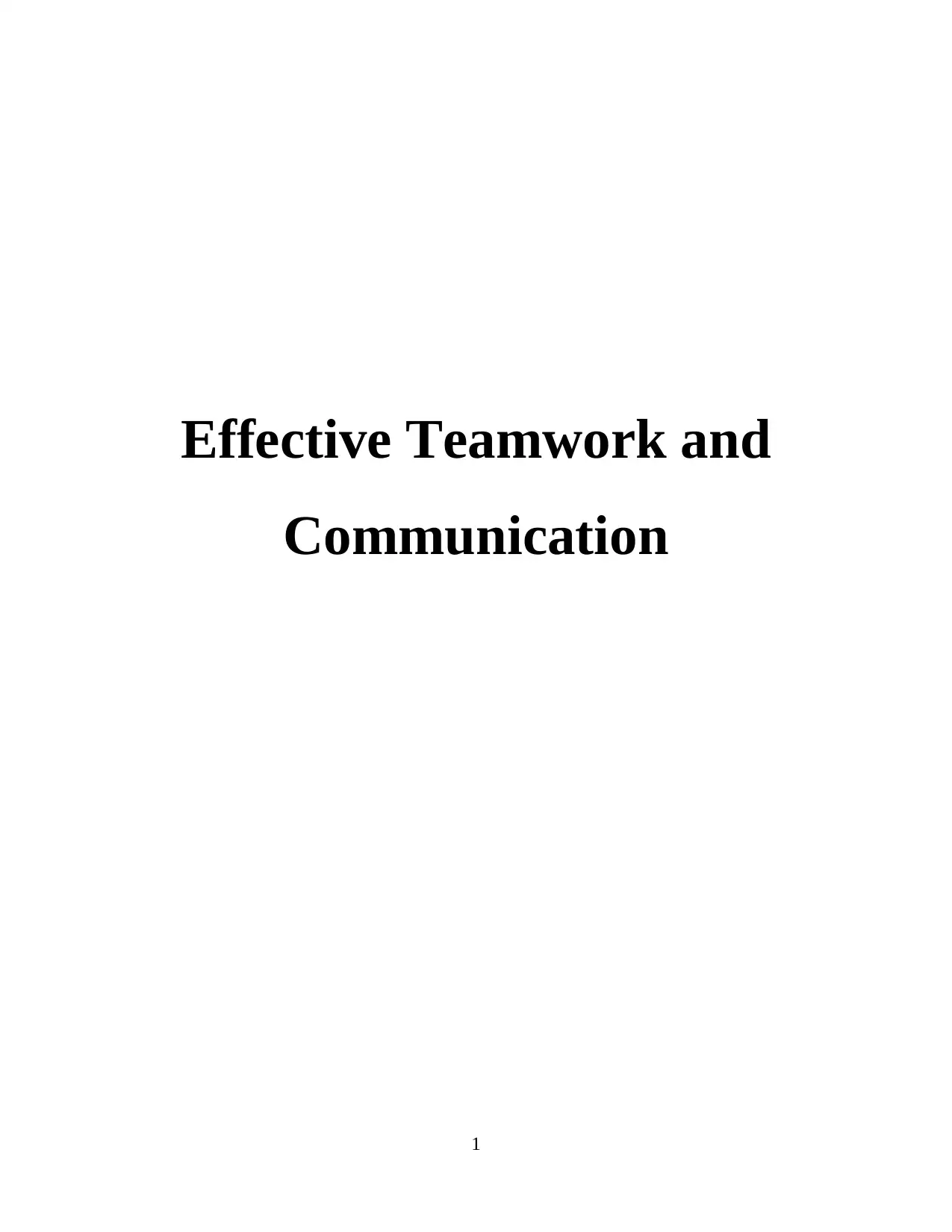
Effective Teamwork and
Communication
1
Communication
1
Secure Best Marks with AI Grader
Need help grading? Try our AI Grader for instant feedback on your assignments.

Contents
1. INTRODUCTION.......................................................................................................................3
2. MODELS OF COMMUNICATION...........................................................................................3
2.1 Shannon and Weaver’s Model of Communication (1948)....................................................3
2.2 Schramm’s Model of Communication (1954).......................................................................5
2.3 Berlo’s Model of Communication (1960).............................................................................6
3. COMMUNICATION SKILLS....................................................................................................7
3.1 Verbal communication skills.................................................................................................7
3.2 Non-verbal communication skills..........................................................................................8
3.3 Listening skills.......................................................................................................................9
4. CONCLUSION..........................................................................................................................10
REFERENCES..............................................................................................................................11
2
1. INTRODUCTION.......................................................................................................................3
2. MODELS OF COMMUNICATION...........................................................................................3
2.1 Shannon and Weaver’s Model of Communication (1948)....................................................3
2.2 Schramm’s Model of Communication (1954).......................................................................5
2.3 Berlo’s Model of Communication (1960).............................................................................6
3. COMMUNICATION SKILLS....................................................................................................7
3.1 Verbal communication skills.................................................................................................7
3.2 Non-verbal communication skills..........................................................................................8
3.3 Listening skills.......................................................................................................................9
4. CONCLUSION..........................................................................................................................10
REFERENCES..............................................................................................................................11
2
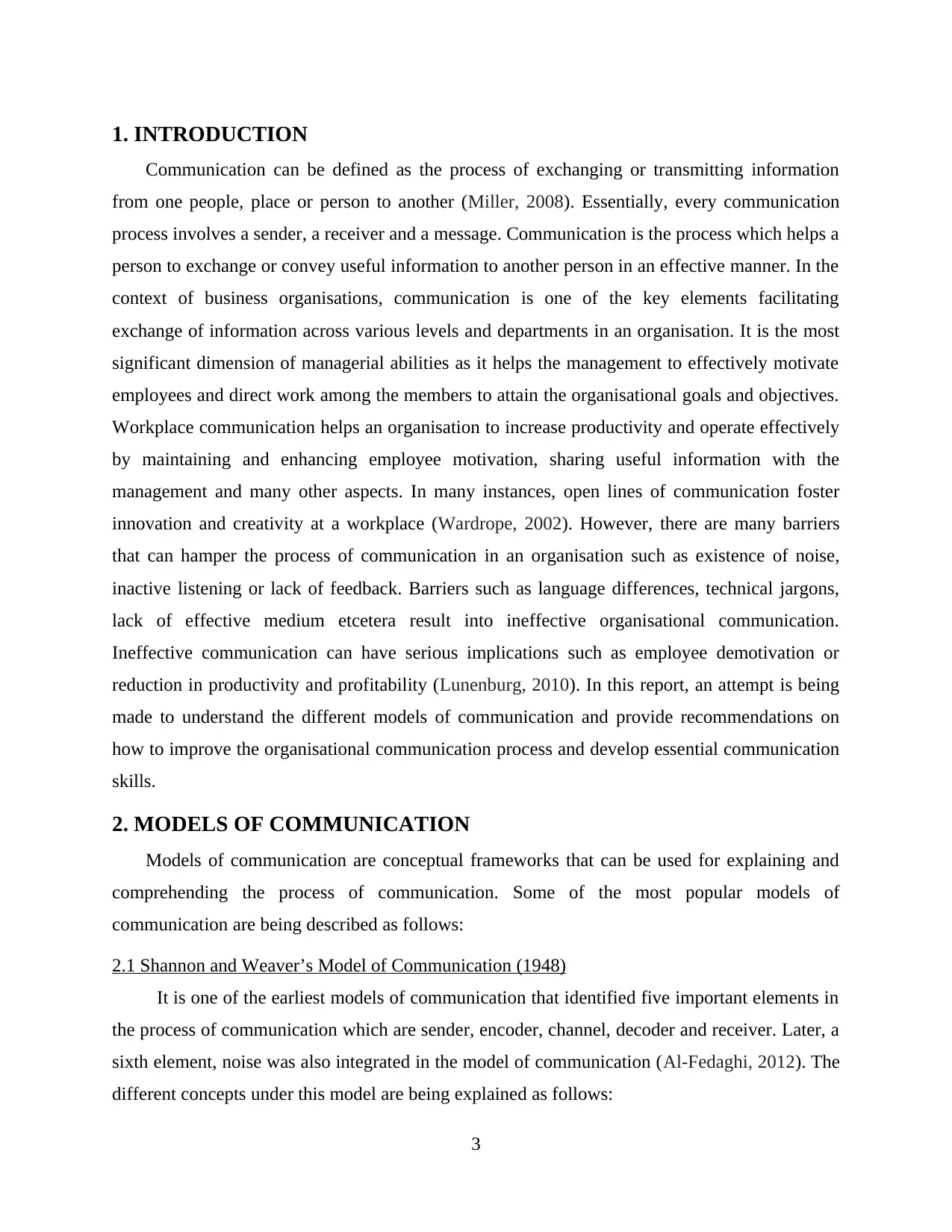
1. INTRODUCTION
Communication can be defined as the process of exchanging or transmitting information
from one people, place or person to another (Miller, 2008). Essentially, every communication
process involves a sender, a receiver and a message. Communication is the process which helps a
person to exchange or convey useful information to another person in an effective manner. In the
context of business organisations, communication is one of the key elements facilitating
exchange of information across various levels and departments in an organisation. It is the most
significant dimension of managerial abilities as it helps the management to effectively motivate
employees and direct work among the members to attain the organisational goals and objectives.
Workplace communication helps an organisation to increase productivity and operate effectively
by maintaining and enhancing employee motivation, sharing useful information with the
management and many other aspects. In many instances, open lines of communication foster
innovation and creativity at a workplace (Wardrope, 2002). However, there are many barriers
that can hamper the process of communication in an organisation such as existence of noise,
inactive listening or lack of feedback. Barriers such as language differences, technical jargons,
lack of effective medium etcetera result into ineffective organisational communication.
Ineffective communication can have serious implications such as employee demotivation or
reduction in productivity and profitability (Lunenburg, 2010). In this report, an attempt is being
made to understand the different models of communication and provide recommendations on
how to improve the organisational communication process and develop essential communication
skills.
2. MODELS OF COMMUNICATION
Models of communication are conceptual frameworks that can be used for explaining and
comprehending the process of communication. Some of the most popular models of
communication are being described as follows:
2.1 Shannon and Weaver’s Model of Communication (1948)
It is one of the earliest models of communication that identified five important elements in
the process of communication which are sender, encoder, channel, decoder and receiver. Later, a
sixth element, noise was also integrated in the model of communication (Al-Fedaghi, 2012). The
different concepts under this model are being explained as follows:
3
Communication can be defined as the process of exchanging or transmitting information
from one people, place or person to another (Miller, 2008). Essentially, every communication
process involves a sender, a receiver and a message. Communication is the process which helps a
person to exchange or convey useful information to another person in an effective manner. In the
context of business organisations, communication is one of the key elements facilitating
exchange of information across various levels and departments in an organisation. It is the most
significant dimension of managerial abilities as it helps the management to effectively motivate
employees and direct work among the members to attain the organisational goals and objectives.
Workplace communication helps an organisation to increase productivity and operate effectively
by maintaining and enhancing employee motivation, sharing useful information with the
management and many other aspects. In many instances, open lines of communication foster
innovation and creativity at a workplace (Wardrope, 2002). However, there are many barriers
that can hamper the process of communication in an organisation such as existence of noise,
inactive listening or lack of feedback. Barriers such as language differences, technical jargons,
lack of effective medium etcetera result into ineffective organisational communication.
Ineffective communication can have serious implications such as employee demotivation or
reduction in productivity and profitability (Lunenburg, 2010). In this report, an attempt is being
made to understand the different models of communication and provide recommendations on
how to improve the organisational communication process and develop essential communication
skills.
2. MODELS OF COMMUNICATION
Models of communication are conceptual frameworks that can be used for explaining and
comprehending the process of communication. Some of the most popular models of
communication are being described as follows:
2.1 Shannon and Weaver’s Model of Communication (1948)
It is one of the earliest models of communication that identified five important elements in
the process of communication which are sender, encoder, channel, decoder and receiver. Later, a
sixth element, noise was also integrated in the model of communication (Al-Fedaghi, 2012). The
different concepts under this model are being explained as follows:
3
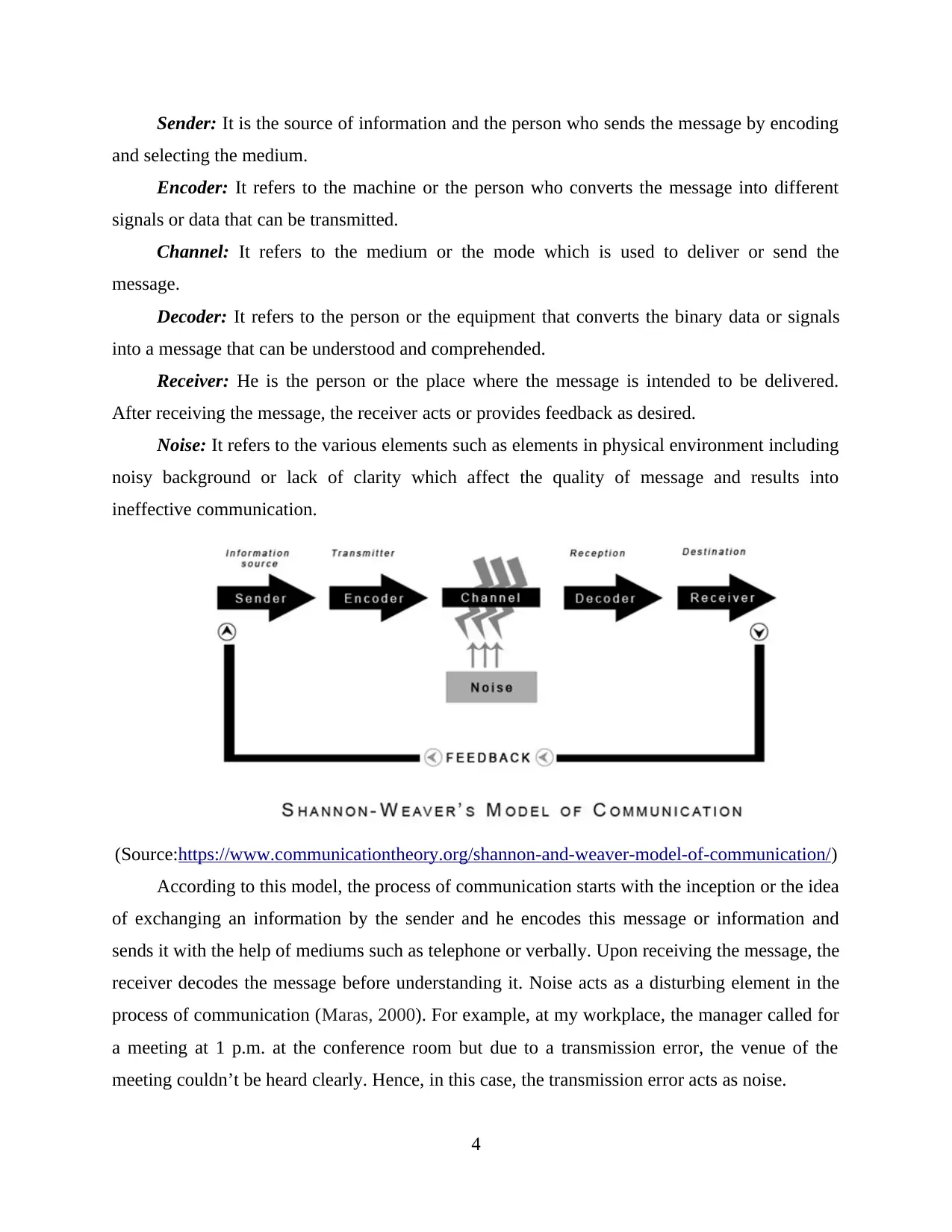
Sender: It is the source of information and the person who sends the message by encoding
and selecting the medium.
Encoder: It refers to the machine or the person who converts the message into different
signals or data that can be transmitted.
Channel: It refers to the medium or the mode which is used to deliver or send the
message.
Decoder: It refers to the person or the equipment that converts the binary data or signals
into a message that can be understood and comprehended.
Receiver: He is the person or the place where the message is intended to be delivered.
After receiving the message, the receiver acts or provides feedback as desired.
Noise: It refers to the various elements such as elements in physical environment including
noisy background or lack of clarity which affect the quality of message and results into
ineffective communication.
(Source:https://www.communicationtheory.org/shannon-and-weaver-model-of-communication/)
According to this model, the process of communication starts with the inception or the idea
of exchanging an information by the sender and he encodes this message or information and
sends it with the help of mediums such as telephone or verbally. Upon receiving the message, the
receiver decodes the message before understanding it. Noise acts as a disturbing element in the
process of communication (Maras, 2000). For example, at my workplace, the manager called for
a meeting at 1 p.m. at the conference room but due to a transmission error, the venue of the
meeting couldn’t be heard clearly. Hence, in this case, the transmission error acts as noise.
4
and selecting the medium.
Encoder: It refers to the machine or the person who converts the message into different
signals or data that can be transmitted.
Channel: It refers to the medium or the mode which is used to deliver or send the
message.
Decoder: It refers to the person or the equipment that converts the binary data or signals
into a message that can be understood and comprehended.
Receiver: He is the person or the place where the message is intended to be delivered.
After receiving the message, the receiver acts or provides feedback as desired.
Noise: It refers to the various elements such as elements in physical environment including
noisy background or lack of clarity which affect the quality of message and results into
ineffective communication.
(Source:https://www.communicationtheory.org/shannon-and-weaver-model-of-communication/)
According to this model, the process of communication starts with the inception or the idea
of exchanging an information by the sender and he encodes this message or information and
sends it with the help of mediums such as telephone or verbally. Upon receiving the message, the
receiver decodes the message before understanding it. Noise acts as a disturbing element in the
process of communication (Maras, 2000). For example, at my workplace, the manager called for
a meeting at 1 p.m. at the conference room but due to a transmission error, the venue of the
meeting couldn’t be heard clearly. Hence, in this case, the transmission error acts as noise.
4
Secure Best Marks with AI Grader
Need help grading? Try our AI Grader for instant feedback on your assignments.
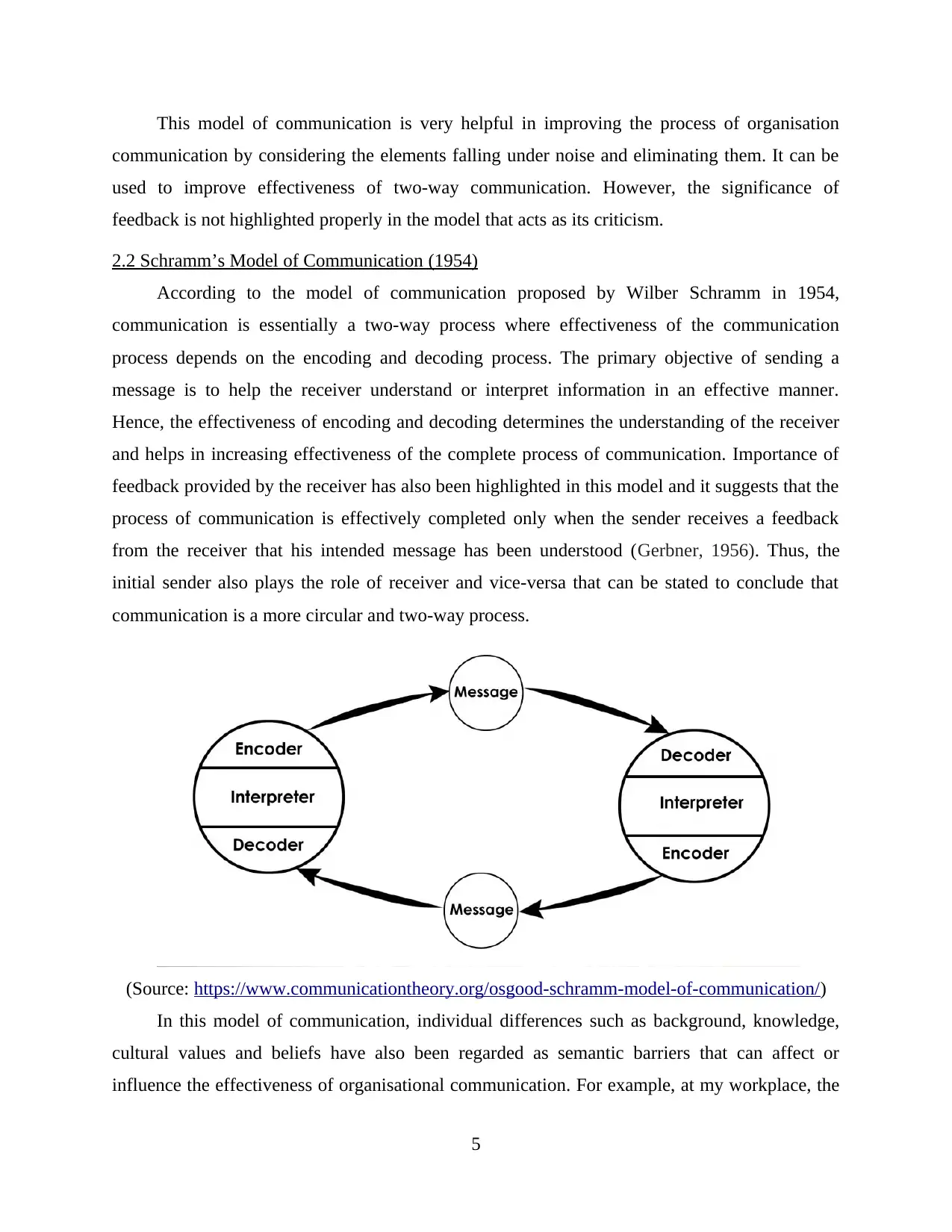
This model of communication is very helpful in improving the process of organisation
communication by considering the elements falling under noise and eliminating them. It can be
used to improve effectiveness of two-way communication. However, the significance of
feedback is not highlighted properly in the model that acts as its criticism.
2.2 Schramm’s Model of Communication (1954)
According to the model of communication proposed by Wilber Schramm in 1954,
communication is essentially a two-way process where effectiveness of the communication
process depends on the encoding and decoding process. The primary objective of sending a
message is to help the receiver understand or interpret information in an effective manner.
Hence, the effectiveness of encoding and decoding determines the understanding of the receiver
and helps in increasing effectiveness of the complete process of communication. Importance of
feedback provided by the receiver has also been highlighted in this model and it suggests that the
process of communication is effectively completed only when the sender receives a feedback
from the receiver that his intended message has been understood (Gerbner, 1956). Thus, the
initial sender also plays the role of receiver and vice-versa that can be stated to conclude that
communication is a more circular and two-way process.
(Source: https://www.communicationtheory.org/osgood-schramm-model-of-communication/)
In this model of communication, individual differences such as background, knowledge,
cultural values and beliefs have also been regarded as semantic barriers that can affect or
influence the effectiveness of organisational communication. For example, at my workplace, the
5
communication by considering the elements falling under noise and eliminating them. It can be
used to improve effectiveness of two-way communication. However, the significance of
feedback is not highlighted properly in the model that acts as its criticism.
2.2 Schramm’s Model of Communication (1954)
According to the model of communication proposed by Wilber Schramm in 1954,
communication is essentially a two-way process where effectiveness of the communication
process depends on the encoding and decoding process. The primary objective of sending a
message is to help the receiver understand or interpret information in an effective manner.
Hence, the effectiveness of encoding and decoding determines the understanding of the receiver
and helps in increasing effectiveness of the complete process of communication. Importance of
feedback provided by the receiver has also been highlighted in this model and it suggests that the
process of communication is effectively completed only when the sender receives a feedback
from the receiver that his intended message has been understood (Gerbner, 1956). Thus, the
initial sender also plays the role of receiver and vice-versa that can be stated to conclude that
communication is a more circular and two-way process.
(Source: https://www.communicationtheory.org/osgood-schramm-model-of-communication/)
In this model of communication, individual differences such as background, knowledge,
cultural values and beliefs have also been regarded as semantic barriers that can affect or
influence the effectiveness of organisational communication. For example, at my workplace, the
5

manager uses simple and clear English without any technical jargons while communicating to
make sure every member of the organisation including foreigners understand and interpret the
message as intended. Feedback also forms an important dimension where the manager receives
confirmation of proper comprehension of the message or information by every employee. This
model is very significant in enhancing the effectiveness of communication by acknowledging
individual cultural and background differences.
2.3 Berlo’s Model of Communication (1960)
Under this model of communication, Berlo identified four major components of the
communication process and identified some factors affecting each component that are being
explained in the following manner:
(Source: https://www.communicationtheory.org/berlos-smcr-model-of-communication/)
Sender:
Sender is the person or the source from where the message or the process of
communication originates. Factors affecting this component of the communication process
include communication skills of the sender, attitude and knowledge of the person, cultural and
background differences, values and beliefs of the person etcetera. Effectiveness at this stage
determines effectiveness of encoding which is influenced by the factors that have been
mentioned (Corman, Trethewey and Goodall, 2007).
Message:
6
make sure every member of the organisation including foreigners understand and interpret the
message as intended. Feedback also forms an important dimension where the manager receives
confirmation of proper comprehension of the message or information by every employee. This
model is very significant in enhancing the effectiveness of communication by acknowledging
individual cultural and background differences.
2.3 Berlo’s Model of Communication (1960)
Under this model of communication, Berlo identified four major components of the
communication process and identified some factors affecting each component that are being
explained in the following manner:
(Source: https://www.communicationtheory.org/berlos-smcr-model-of-communication/)
Sender:
Sender is the person or the source from where the message or the process of
communication originates. Factors affecting this component of the communication process
include communication skills of the sender, attitude and knowledge of the person, cultural and
background differences, values and beliefs of the person etcetera. Effectiveness at this stage
determines effectiveness of encoding which is influenced by the factors that have been
mentioned (Corman, Trethewey and Goodall, 2007).
Message:
6
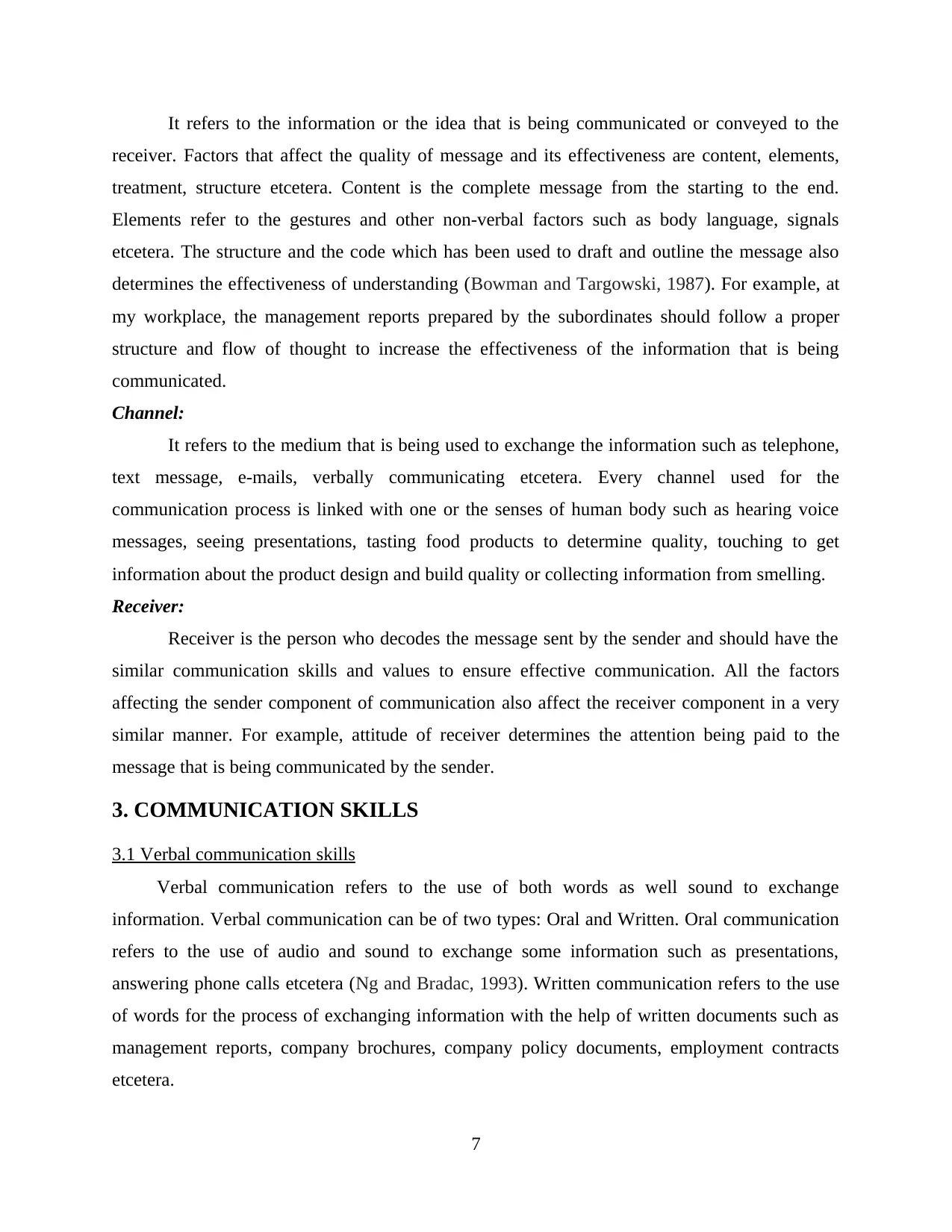
It refers to the information or the idea that is being communicated or conveyed to the
receiver. Factors that affect the quality of message and its effectiveness are content, elements,
treatment, structure etcetera. Content is the complete message from the starting to the end.
Elements refer to the gestures and other non-verbal factors such as body language, signals
etcetera. The structure and the code which has been used to draft and outline the message also
determines the effectiveness of understanding (Bowman and Targowski, 1987). For example, at
my workplace, the management reports prepared by the subordinates should follow a proper
structure and flow of thought to increase the effectiveness of the information that is being
communicated.
Channel:
It refers to the medium that is being used to exchange the information such as telephone,
text message, e-mails, verbally communicating etcetera. Every channel used for the
communication process is linked with one or the senses of human body such as hearing voice
messages, seeing presentations, tasting food products to determine quality, touching to get
information about the product design and build quality or collecting information from smelling.
Receiver:
Receiver is the person who decodes the message sent by the sender and should have the
similar communication skills and values to ensure effective communication. All the factors
affecting the sender component of communication also affect the receiver component in a very
similar manner. For example, attitude of receiver determines the attention being paid to the
message that is being communicated by the sender.
3. COMMUNICATION SKILLS
3.1 Verbal communication skills
Verbal communication refers to the use of both words as well sound to exchange
information. Verbal communication can be of two types: Oral and Written. Oral communication
refers to the use of audio and sound to exchange some information such as presentations,
answering phone calls etcetera (Ng and Bradac, 1993). Written communication refers to the use
of words for the process of exchanging information with the help of written documents such as
management reports, company brochures, company policy documents, employment contracts
etcetera.
7
receiver. Factors that affect the quality of message and its effectiveness are content, elements,
treatment, structure etcetera. Content is the complete message from the starting to the end.
Elements refer to the gestures and other non-verbal factors such as body language, signals
etcetera. The structure and the code which has been used to draft and outline the message also
determines the effectiveness of understanding (Bowman and Targowski, 1987). For example, at
my workplace, the management reports prepared by the subordinates should follow a proper
structure and flow of thought to increase the effectiveness of the information that is being
communicated.
Channel:
It refers to the medium that is being used to exchange the information such as telephone,
text message, e-mails, verbally communicating etcetera. Every channel used for the
communication process is linked with one or the senses of human body such as hearing voice
messages, seeing presentations, tasting food products to determine quality, touching to get
information about the product design and build quality or collecting information from smelling.
Receiver:
Receiver is the person who decodes the message sent by the sender and should have the
similar communication skills and values to ensure effective communication. All the factors
affecting the sender component of communication also affect the receiver component in a very
similar manner. For example, attitude of receiver determines the attention being paid to the
message that is being communicated by the sender.
3. COMMUNICATION SKILLS
3.1 Verbal communication skills
Verbal communication refers to the use of both words as well sound to exchange
information. Verbal communication can be of two types: Oral and Written. Oral communication
refers to the use of audio and sound to exchange some information such as presentations,
answering phone calls etcetera (Ng and Bradac, 1993). Written communication refers to the use
of words for the process of exchanging information with the help of written documents such as
management reports, company brochures, company policy documents, employment contracts
etcetera.
7
Paraphrase This Document
Need a fresh take? Get an instant paraphrase of this document with our AI Paraphraser
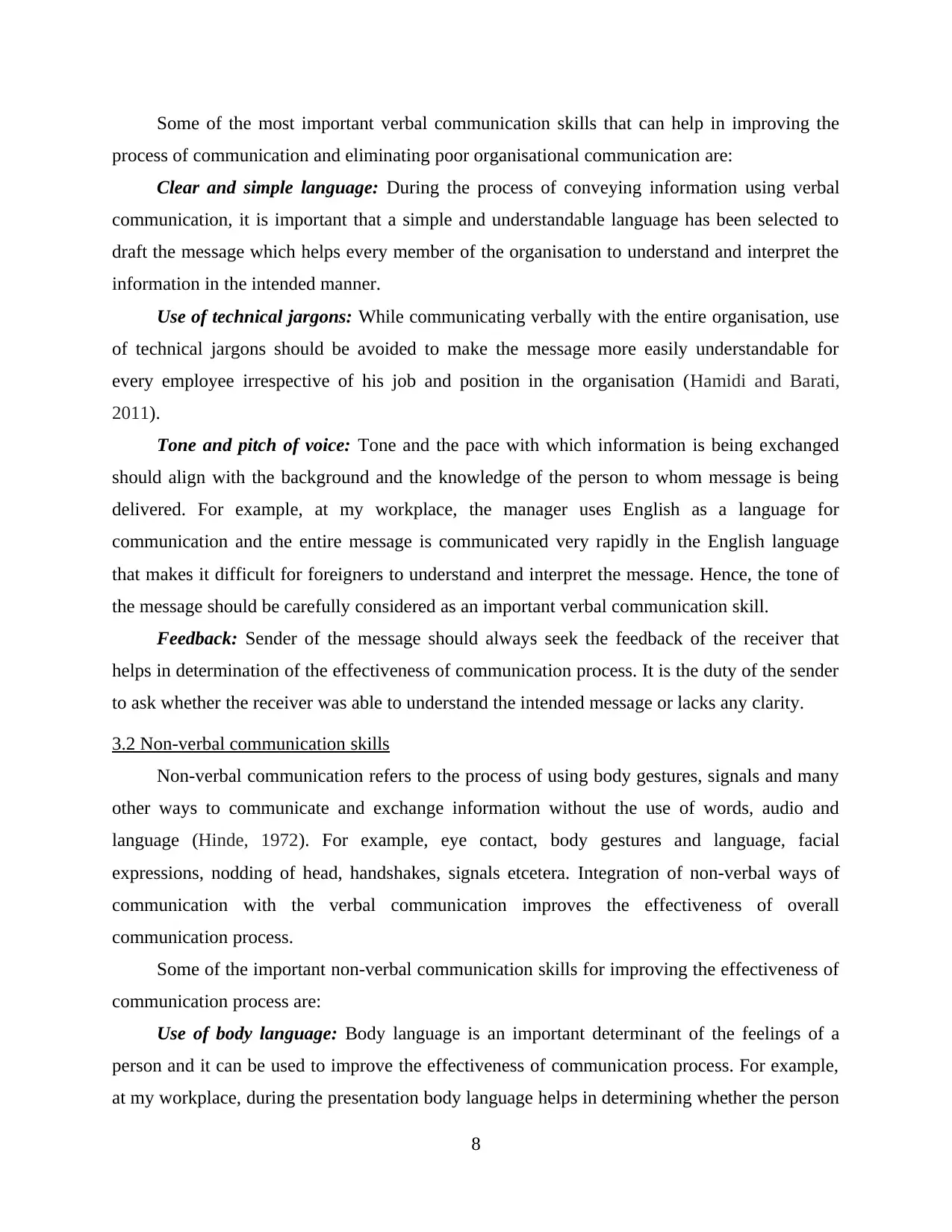
Some of the most important verbal communication skills that can help in improving the
process of communication and eliminating poor organisational communication are:
Clear and simple language: During the process of conveying information using verbal
communication, it is important that a simple and understandable language has been selected to
draft the message which helps every member of the organisation to understand and interpret the
information in the intended manner.
Use of technical jargons: While communicating verbally with the entire organisation, use
of technical jargons should be avoided to make the message more easily understandable for
every employee irrespective of his job and position in the organisation (Hamidi and Barati,
2011).
Tone and pitch of voice: Tone and the pace with which information is being exchanged
should align with the background and the knowledge of the person to whom message is being
delivered. For example, at my workplace, the manager uses English as a language for
communication and the entire message is communicated very rapidly in the English language
that makes it difficult for foreigners to understand and interpret the message. Hence, the tone of
the message should be carefully considered as an important verbal communication skill.
Feedback: Sender of the message should always seek the feedback of the receiver that
helps in determination of the effectiveness of communication process. It is the duty of the sender
to ask whether the receiver was able to understand the intended message or lacks any clarity.
3.2 Non-verbal communication skills
Non-verbal communication refers to the process of using body gestures, signals and many
other ways to communicate and exchange information without the use of words, audio and
language (Hinde, 1972). For example, eye contact, body gestures and language, facial
expressions, nodding of head, handshakes, signals etcetera. Integration of non-verbal ways of
communication with the verbal communication improves the effectiveness of overall
communication process.
Some of the important non-verbal communication skills for improving the effectiveness of
communication process are:
Use of body language: Body language is an important determinant of the feelings of a
person and it can be used to improve the effectiveness of communication process. For example,
at my workplace, during the presentation body language helps in determining whether the person
8
process of communication and eliminating poor organisational communication are:
Clear and simple language: During the process of conveying information using verbal
communication, it is important that a simple and understandable language has been selected to
draft the message which helps every member of the organisation to understand and interpret the
information in the intended manner.
Use of technical jargons: While communicating verbally with the entire organisation, use
of technical jargons should be avoided to make the message more easily understandable for
every employee irrespective of his job and position in the organisation (Hamidi and Barati,
2011).
Tone and pitch of voice: Tone and the pace with which information is being exchanged
should align with the background and the knowledge of the person to whom message is being
delivered. For example, at my workplace, the manager uses English as a language for
communication and the entire message is communicated very rapidly in the English language
that makes it difficult for foreigners to understand and interpret the message. Hence, the tone of
the message should be carefully considered as an important verbal communication skill.
Feedback: Sender of the message should always seek the feedback of the receiver that
helps in determination of the effectiveness of communication process. It is the duty of the sender
to ask whether the receiver was able to understand the intended message or lacks any clarity.
3.2 Non-verbal communication skills
Non-verbal communication refers to the process of using body gestures, signals and many
other ways to communicate and exchange information without the use of words, audio and
language (Hinde, 1972). For example, eye contact, body gestures and language, facial
expressions, nodding of head, handshakes, signals etcetera. Integration of non-verbal ways of
communication with the verbal communication improves the effectiveness of overall
communication process.
Some of the important non-verbal communication skills for improving the effectiveness of
communication process are:
Use of body language: Body language is an important determinant of the feelings of a
person and it can be used to improve the effectiveness of communication process. For example,
at my workplace, during the presentation body language helps in determining whether the person
8
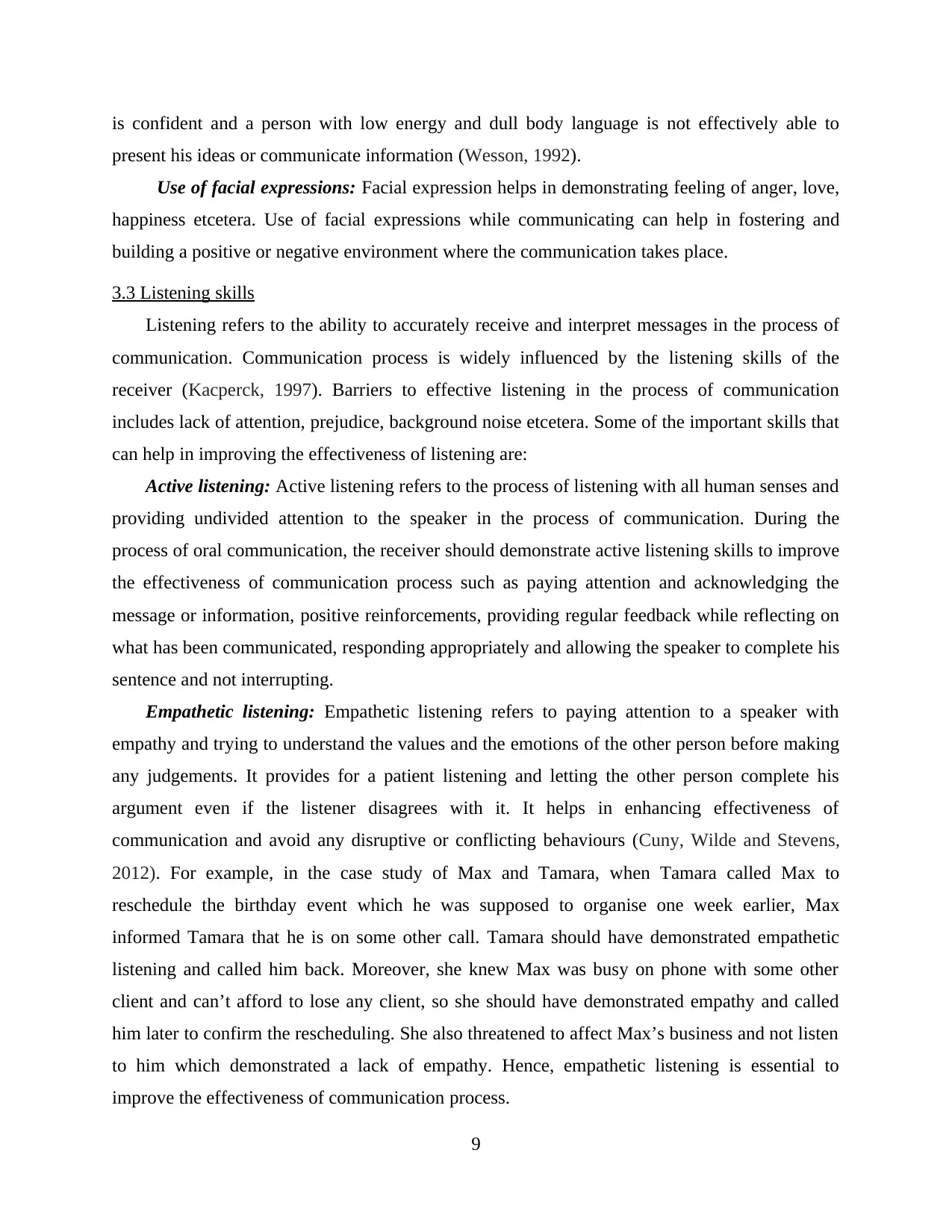
is confident and a person with low energy and dull body language is not effectively able to
present his ideas or communicate information (Wesson, 1992).
Use of facial expressions: Facial expression helps in demonstrating feeling of anger, love,
happiness etcetera. Use of facial expressions while communicating can help in fostering and
building a positive or negative environment where the communication takes place.
3.3 Listening skills
Listening refers to the ability to accurately receive and interpret messages in the process of
communication. Communication process is widely influenced by the listening skills of the
receiver (Kacperck, 1997). Barriers to effective listening in the process of communication
includes lack of attention, prejudice, background noise etcetera. Some of the important skills that
can help in improving the effectiveness of listening are:
Active listening: Active listening refers to the process of listening with all human senses and
providing undivided attention to the speaker in the process of communication. During the
process of oral communication, the receiver should demonstrate active listening skills to improve
the effectiveness of communication process such as paying attention and acknowledging the
message or information, positive reinforcements, providing regular feedback while reflecting on
what has been communicated, responding appropriately and allowing the speaker to complete his
sentence and not interrupting.
Empathetic listening: Empathetic listening refers to paying attention to a speaker with
empathy and trying to understand the values and the emotions of the other person before making
any judgements. It provides for a patient listening and letting the other person complete his
argument even if the listener disagrees with it. It helps in enhancing effectiveness of
communication and avoid any disruptive or conflicting behaviours (Cuny, Wilde and Stevens,
2012). For example, in the case study of Max and Tamara, when Tamara called Max to
reschedule the birthday event which he was supposed to organise one week earlier, Max
informed Tamara that he is on some other call. Tamara should have demonstrated empathetic
listening and called him back. Moreover, she knew Max was busy on phone with some other
client and can’t afford to lose any client, so she should have demonstrated empathy and called
him later to confirm the rescheduling. She also threatened to affect Max’s business and not listen
to him which demonstrated a lack of empathy. Hence, empathetic listening is essential to
improve the effectiveness of communication process.
9
present his ideas or communicate information (Wesson, 1992).
Use of facial expressions: Facial expression helps in demonstrating feeling of anger, love,
happiness etcetera. Use of facial expressions while communicating can help in fostering and
building a positive or negative environment where the communication takes place.
3.3 Listening skills
Listening refers to the ability to accurately receive and interpret messages in the process of
communication. Communication process is widely influenced by the listening skills of the
receiver (Kacperck, 1997). Barriers to effective listening in the process of communication
includes lack of attention, prejudice, background noise etcetera. Some of the important skills that
can help in improving the effectiveness of listening are:
Active listening: Active listening refers to the process of listening with all human senses and
providing undivided attention to the speaker in the process of communication. During the
process of oral communication, the receiver should demonstrate active listening skills to improve
the effectiveness of communication process such as paying attention and acknowledging the
message or information, positive reinforcements, providing regular feedback while reflecting on
what has been communicated, responding appropriately and allowing the speaker to complete his
sentence and not interrupting.
Empathetic listening: Empathetic listening refers to paying attention to a speaker with
empathy and trying to understand the values and the emotions of the other person before making
any judgements. It provides for a patient listening and letting the other person complete his
argument even if the listener disagrees with it. It helps in enhancing effectiveness of
communication and avoid any disruptive or conflicting behaviours (Cuny, Wilde and Stevens,
2012). For example, in the case study of Max and Tamara, when Tamara called Max to
reschedule the birthday event which he was supposed to organise one week earlier, Max
informed Tamara that he is on some other call. Tamara should have demonstrated empathetic
listening and called him back. Moreover, she knew Max was busy on phone with some other
client and can’t afford to lose any client, so she should have demonstrated empathy and called
him later to confirm the rescheduling. She also threatened to affect Max’s business and not listen
to him which demonstrated a lack of empathy. Hence, empathetic listening is essential to
improve the effectiveness of communication process.
9
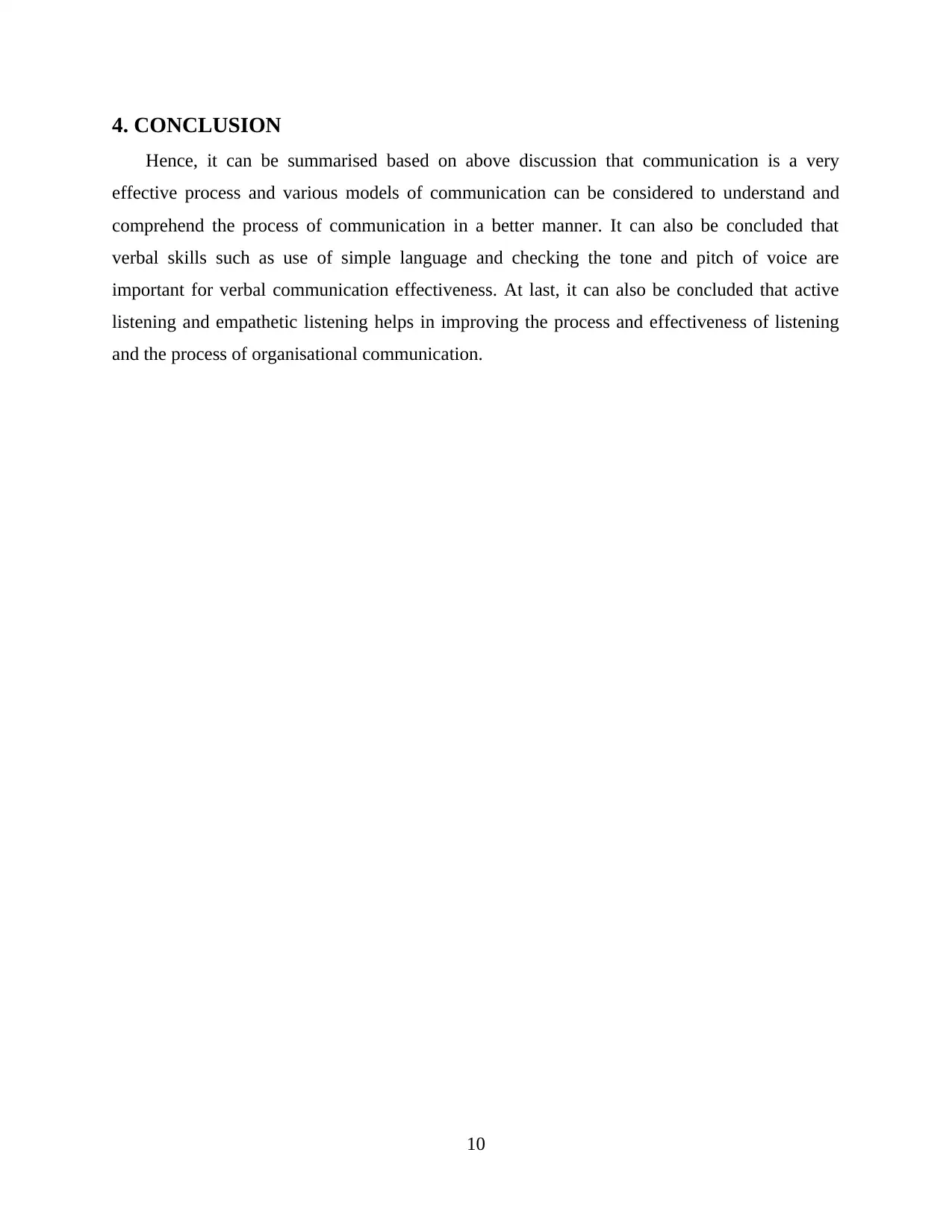
4. CONCLUSION
Hence, it can be summarised based on above discussion that communication is a very
effective process and various models of communication can be considered to understand and
comprehend the process of communication in a better manner. It can also be concluded that
verbal skills such as use of simple language and checking the tone and pitch of voice are
important for verbal communication effectiveness. At last, it can also be concluded that active
listening and empathetic listening helps in improving the process and effectiveness of listening
and the process of organisational communication.
10
Hence, it can be summarised based on above discussion that communication is a very
effective process and various models of communication can be considered to understand and
comprehend the process of communication in a better manner. It can also be concluded that
verbal skills such as use of simple language and checking the tone and pitch of voice are
important for verbal communication effectiveness. At last, it can also be concluded that active
listening and empathetic listening helps in improving the process and effectiveness of listening
and the process of organisational communication.
10
Secure Best Marks with AI Grader
Need help grading? Try our AI Grader for instant feedback on your assignments.
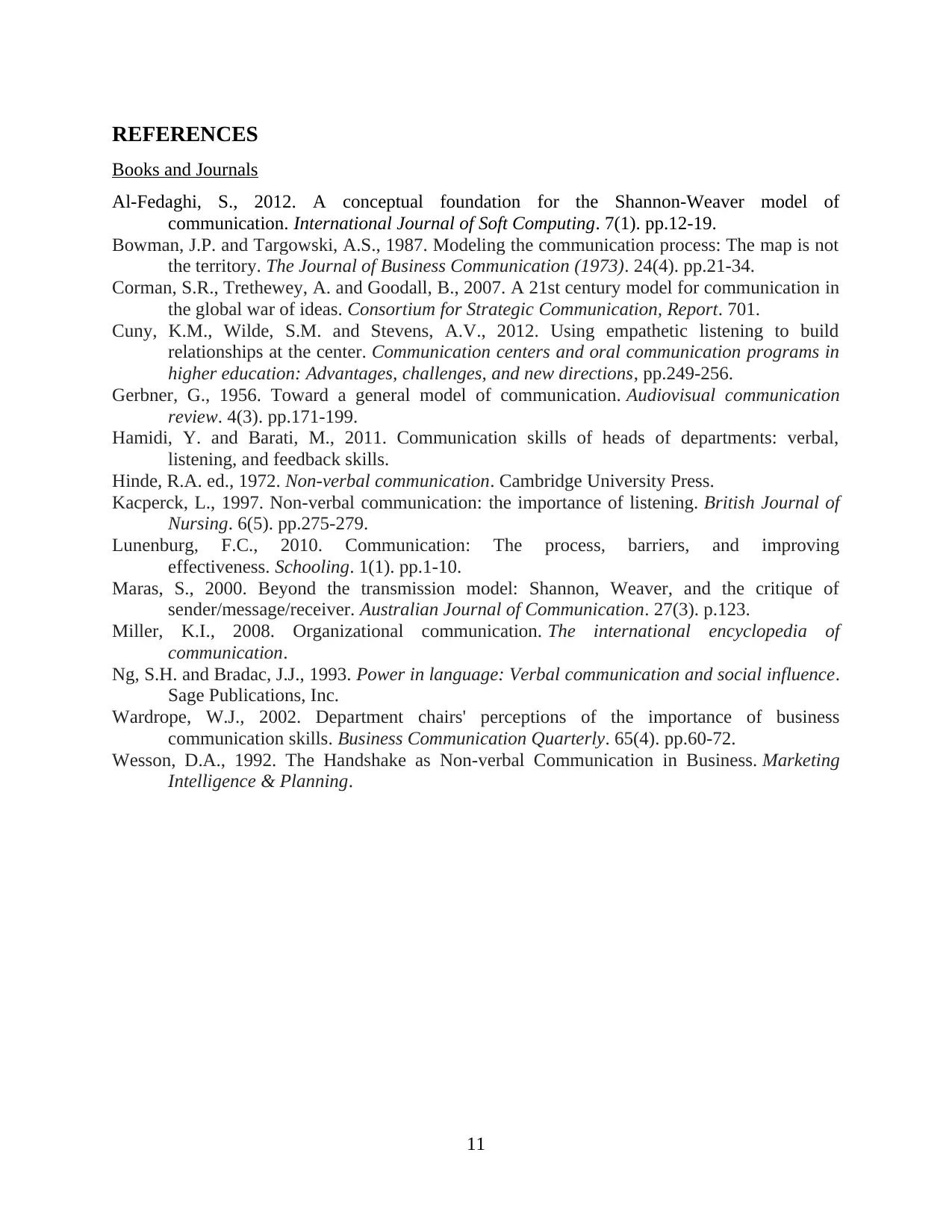
REFERENCES
Books and Journals
Al-Fedaghi, S., 2012. A conceptual foundation for the Shannon-Weaver model of
communication. International Journal of Soft Computing. 7(1). pp.12-19.
Bowman, J.P. and Targowski, A.S., 1987. Modeling the communication process: The map is not
the territory. The Journal of Business Communication (1973). 24(4). pp.21-34.
Corman, S.R., Trethewey, A. and Goodall, B., 2007. A 21st century model for communication in
the global war of ideas. Consortium for Strategic Communication, Report. 701.
Cuny, K.M., Wilde, S.M. and Stevens, A.V., 2012. Using empathetic listening to build
relationships at the center. Communication centers and oral communication programs in
higher education: Advantages, challenges, and new directions, pp.249-256.
Gerbner, G., 1956. Toward a general model of communication. Audiovisual communication
review. 4(3). pp.171-199.
Hamidi, Y. and Barati, M., 2011. Communication skills of heads of departments: verbal,
listening, and feedback skills.
Hinde, R.A. ed., 1972. Non-verbal communication. Cambridge University Press.
Kacperck, L., 1997. Non-verbal communication: the importance of listening. British Journal of
Nursing. 6(5). pp.275-279.
Lunenburg, F.C., 2010. Communication: The process, barriers, and improving
effectiveness. Schooling. 1(1). pp.1-10.
Maras, S., 2000. Beyond the transmission model: Shannon, Weaver, and the critique of
sender/message/receiver. Australian Journal of Communication. 27(3). p.123.
Miller, K.I., 2008. Organizational communication. The international encyclopedia of
communication.
Ng, S.H. and Bradac, J.J., 1993. Power in language: Verbal communication and social influence.
Sage Publications, Inc.
Wardrope, W.J., 2002. Department chairs' perceptions of the importance of business
communication skills. Business Communication Quarterly. 65(4). pp.60-72.
Wesson, D.A., 1992. The Handshake as Non‐verbal Communication in Business. Marketing
Intelligence & Planning.
11
Books and Journals
Al-Fedaghi, S., 2012. A conceptual foundation for the Shannon-Weaver model of
communication. International Journal of Soft Computing. 7(1). pp.12-19.
Bowman, J.P. and Targowski, A.S., 1987. Modeling the communication process: The map is not
the territory. The Journal of Business Communication (1973). 24(4). pp.21-34.
Corman, S.R., Trethewey, A. and Goodall, B., 2007. A 21st century model for communication in
the global war of ideas. Consortium for Strategic Communication, Report. 701.
Cuny, K.M., Wilde, S.M. and Stevens, A.V., 2012. Using empathetic listening to build
relationships at the center. Communication centers and oral communication programs in
higher education: Advantages, challenges, and new directions, pp.249-256.
Gerbner, G., 1956. Toward a general model of communication. Audiovisual communication
review. 4(3). pp.171-199.
Hamidi, Y. and Barati, M., 2011. Communication skills of heads of departments: verbal,
listening, and feedback skills.
Hinde, R.A. ed., 1972. Non-verbal communication. Cambridge University Press.
Kacperck, L., 1997. Non-verbal communication: the importance of listening. British Journal of
Nursing. 6(5). pp.275-279.
Lunenburg, F.C., 2010. Communication: The process, barriers, and improving
effectiveness. Schooling. 1(1). pp.1-10.
Maras, S., 2000. Beyond the transmission model: Shannon, Weaver, and the critique of
sender/message/receiver. Australian Journal of Communication. 27(3). p.123.
Miller, K.I., 2008. Organizational communication. The international encyclopedia of
communication.
Ng, S.H. and Bradac, J.J., 1993. Power in language: Verbal communication and social influence.
Sage Publications, Inc.
Wardrope, W.J., 2002. Department chairs' perceptions of the importance of business
communication skills. Business Communication Quarterly. 65(4). pp.60-72.
Wesson, D.A., 1992. The Handshake as Non‐verbal Communication in Business. Marketing
Intelligence & Planning.
11
1 out of 11
Related Documents
Your All-in-One AI-Powered Toolkit for Academic Success.
+13062052269
info@desklib.com
Available 24*7 on WhatsApp / Email
![[object Object]](/_next/static/media/star-bottom.7253800d.svg)
Unlock your academic potential
© 2024 | Zucol Services PVT LTD | All rights reserved.




